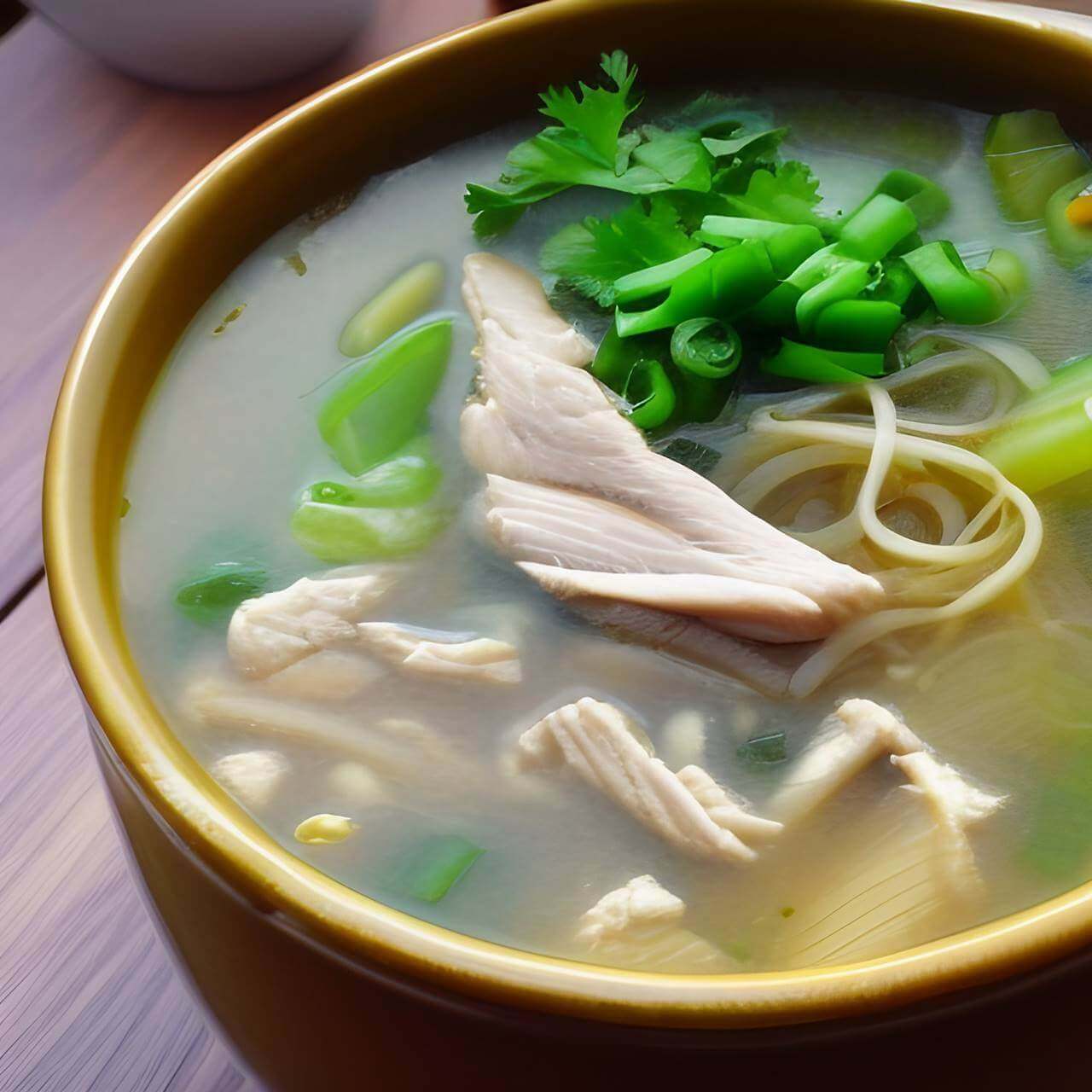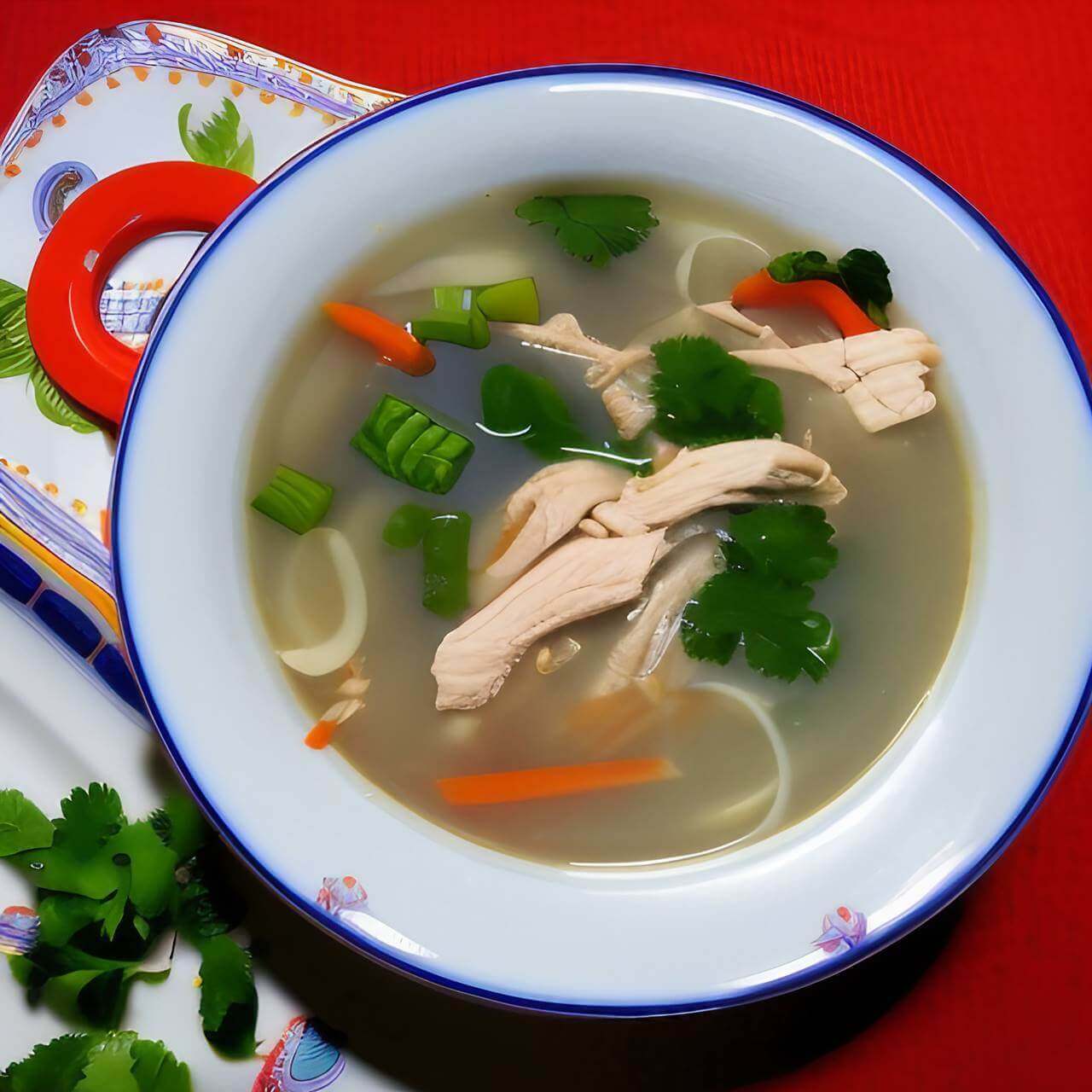On frigid, rainy days, many Filipino homes desire something warm to kickstart their mornings. It’s often difficult to leave the comfort of your bed on those mornings – luckily this delicious chicken sotanghon soup recipe is here for you! This savory dish has been a friend and companion in times of cold weather throughout Filipino households.
Filipino soup is a household favorite and what makes it unique are the noodles. Unlike other cellophane varieties, these slippery strands make for an effortless eating experience. A single bowl of this soup provides you with a complete meal that’s both heart-warming and flavorful – plus, its nutrients can help to strengthen your immune system!
Also Read: How to Cook Homemade Filipino Beef Tapa
This scrumptious soup is a tantalizing combination of shredded chicken, sotanghon noodles, carrots and cabbage. Drizzle it with roasted garlic, scallions and fish sauce for an unforgettable taste that will make your dish stand out! I love making Filipino-style noodle soup and my version is unique in that I use bone-in chicken wings instead of the more traditional shredded chicken parts. These are cut up into small, manageable pieces which add flavor to the dish and make it easier to eat. Delicious and wholesome, chicken wings provide the perfect addition to a nourishing soup.
Not only do they keep moist and avoid becoming stringy like dry flaked meat would, but the bone-rich morsels also bring an extra depth of flavor to your broth. Combined with aromatic spices, nutrient-packed vegetables, and mouthwatering toppings; you’ll have yourself an irresistibly hearty bowl of goodness!
If you desire to create a hearty, soul-warming soup that doesn’t require much effort, why not try making some chicken sotanghon? Read and follow the recipe below for your perfect bowl of comfort.

Ingredients
- Five hundred grams of succulent chicken (with its bones intact).
- For a delicious dish, prepare 150g of vermicelli noodles.
- 1 medium carrot (thinly sliced)
- 1 medium onion (chopped)
- 4 cloves of garlic (minced)
- 2 tablespoons celery stalks (minced)
- 1 piece chicken broth cube
- 1 tablespoon safflower or annatto seeds
- Four to five bay leaves
- Balance the flavors of your dish with a few generous splashes of fish sauce.
- salt and pepper to taste
- oil for sautéing
Steps to Make Philippine Chicken Sotanghon Soup
- Place the chicken in a pot and add bay leaves, then cover it with water. When it begins to boil, remove all of the white foam that appears on top using a spoon. Allow the chicken to cook for 10-15 minutes over medium-low heat until cooked through.
- After it’s boiled, move the chicken onto a plate and tear it apart to separate its flesh from bones. Then keep the stock for your soup! The shredded meat should be set aside now.
- To make the vermicelli noodles soft and pliable, it is essential to let them soak for a minimum of 10 minutes.
- Heat a pan with some oil in it, then sauté the garlic, onions and shredded chicken for several minutes. Enhance your dish’s flavor by seasoning it with generous amounts of salt and ground black pepper. Finally, toss in the celery stalks for a few seconds to make sure they are cooked through.
- Afterwards, put in the chicken broth cube. Add 5 to 6 cups of chicken stock and even more water if you wish for a thinner sotanghon soup.
- Once the pot of water is boiling, stir in the softened vermicelli noodles. Give your dish a beautiful yellow hue by adding safflower or annatto. Let it simmer for several minutes until tender perfection, and enjoy your delectable creation!
- Experiment with a flavor test to refine the taste using fish sauce.
- To finish off the dish, add the carrots and sauté for a further 2-3 minutes until they are tender.
- Carefully pour the steaming chicken sotanghon soup into a serving bowl and indulge in its warmth!

Tips
- To get the most flavorful results, I suggest utilizing bone-in chicken parts. However, if you’re looking for a more economical and faster alternative, leftover rotisserie chicken is an excellent option to consider. For a vegan-friendly option, substitute the chicken with mushrooms and vegetable broth. Taste your soup as you go! Adjust the flavors to your preference by adding more or less salt, fish sauce and pepper if necessary. Serve with freshly chopped scallions or spring onions for an added zing. Enjoy!
- For this recipe, Chinese celery, carrots and napa cabbage are all essential ingredients. To add an extra burst of flavor to the dish, you may want to consider adding some shitake or wood ear mushrooms as well as pechay and Baguio beans. Feel free to mix it up however you choose!
- To prevent them from overcooking, I never presoak the noodles. Instead, simply drop in the dry coils into the hot broth and press down for a few moments to allow them to cook and soften up.
- Chicken is the protein of choice for this recipe, however, you can also experiment with diced pork, meatballs, shrimp or even crispy tofu for a unique flavor.
- Satisfy your mid-day cravings with a savory bowl of chicken sotanghon! This tasty and filling treat can be served alongside steamed rice, pandesal, or puto for an even more scrumptious meal.
- Carefully spoon the soup into individual bowls and garnish it with crisp garlic, freshly-chopped green onions, and a sliced hard-boiled egg for an added layer of flavor.
- Allow leftovers to cool completely and store in a container with a tight-fitting lid without the toppings. Refrigerate for up to 3 days. Reheat by microwaving for about 1-2 minutes. Enjoy your homemade chicken sotanghon soup! Chicken sotanghon is the perfect comfort food for any occasion. Rich in flavor and simple to make, this delightful meal can be served as a main dish or even as an appetizer to kick off the night
- As with any noodle or pasta recipes, this soup does not freeze well as the sotanghon tends to change texture when frozen and thawed.
- To reheat, transfer to a sauce pot and heat until completely warmed through. Add more broth or water as needed to loosen the consistency and adjust seasonings to taste.
- Roasted garlic and finely chopped scallions can completely transform your dish – don’t forget to add them!
Frequently Asked Questions
1. How do I make the sotanghon noodles soft?
To make the noodles soft, add them directly into the simmering broth and press down for a few moments to allow them to cook and soften up.
2. What is an alternative protein option for this recipe?
You can experiment with diced pork, meatballs, shrimp or even crispy tofu for a unique flavor.
3. How can I store the leftovers?
Allow the leftovers to cool completely and store in a container with a tight-fitting lid without the toppings. Refrigerate for up to 3 days. Reheat by microwaving for about 1-2 minutes. Enjoy your homemade chicken sotanghon soup!
4. Does this recipe freeze well?
No, this soup does not freeze well as the sotanghon tends to change texture when frozen and thawed. To reheat, transfer to a sauce pot and heat until completely warmed through. Add more broth or water as needed to loosen the consistency and adjust seasonings to taste.
5. What are the best topping options for this recipe?
Roasted garlic and finely chopped scallions can completely transform your dish – don’t forget to add them! You may also want to consider adding some freshly chopped herbs like cilantro, parsley or basil for a pop of freshness. For an extra layer of flavor, top it off with a sliced hard-boiled egg. Enjoy!

Summary
Making Chicken Sotanghon Soup is a delicious and rewarding experience. From the aromatic broth to the perfectly cooked noodles, it’s sure to be an instant hit with your family or friends. With just a few simple ingredients like celery, carrots, safflower, annatto and vermicelli noodles you can create this flavorful dish in no time!
Plus, there are endless possibilities for customization so feel free to add some of your favorite vegetables or proteins. Whether you serve it as a main course or an appetizer – enjoy every spoonful of this delightful comfort food!